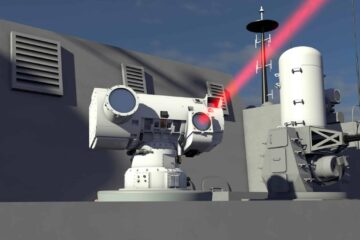but timeframes and capabilities are to be confirmed
The Type 32 frigate’s future as a longer-term RN procurement programme appears to have been reinforced in recent statements by senior government and RN officials. However, programme timeframes and platform capabilities will be determined when more is known about future threats, emerging technologies, and evolving RN frigate capability requirements.
“It is absolutely the intention of the RN to have more frigates and destroyers, including the Type 32,” UK Secretary of State for Defence Ben Wallace told a Parliamentary debate on British naval shipbuilding on 30 January. Current RN programme priorities include the in-build City-class Type 26 and Inspiration-class Type 31 frigates. Beyond these programmes, Wallace explained, “What the Type 32s are going to be, how they will be designed, and who will build them is obviously a matter for [consideration] between now and towards the centre of the decade.”
UK Minister for Defence Procurement (MinDP) Alex Chalk reiterated that Type 32 remains part of plans to renew RN capability after 2030 and to establish a frigate pipeline. MinDP also provided details on the Type 32 programme, noting that the concept phase began in September 2022 and that an outline business case will be presented in Spring 2024. “The programme and procurement strategy will be decided following the concept phase, in the normal way,” he added.
From the RN’s perspective, Vice Admiral Paul Marshall – the navy’s Senior Responsible Owner (SRO) for the Type 31 frigate and Fleet Solid Support ship programmes – told a 31 January House of Commons Defence Committee hearing on the UK’s National Shipbuilding Strategy that a budget will only be set for the Type 32 programme once the business case is released. Noting that the RN is currently reviewing the ‘order of buy’ for navy platforms set against future requirements, Vice Adm Marshall said “the decision is some way off about what follows on either from Type 31 or, indeed, Type 32, after the concept phase.”
“As we go through the concept stage, we will get a better idea of what the [Type 32] programme will look like,” Commodore Stephen Roberts, the Type 26 programme SRO, added.
Assessing these statements, it appears that Type 32 remains in RN plans, currently. Consequently, the key questions are when it might be delivered and what it might look like.

In terms of timeframe, a RN spokesperson told Naval News on 7 February :
“The Type 32 is planned after the Type 31 at the end of the decade. Its design and capabilities will depend on what the navy’s needs are at the middle of the decade. The strategic and long-term investments continue to be on track and will increase the capability and size of the fleet.”
In terms of capability, the RN is looking to balance investment across the fleet to enable it to deal with current and future threats. This includes balancing investment between surface and sub-surface capability, and between crewed and uncrewed capability, for example.
With Type 26 and Type 31 still to enter operational service, the RN will still have much to learn from these two programmes about future frigate capabilities, set against current and future threats, technologies, and operational requirements. These factors will inform what the RN wants and needs with Type 32.
For example, the current pace of technological change is such that the RN is likely to wish to spend time understanding how future technology may shape the threats a frigate will face, and the capabilities it could use to address them. Indeed, such assessment is likely to be central to ‘blue skies thinking’ conducted within the concept phase. Moreover, Type 31 has proved to be an export success. This also could drive what the RN and UK want from Type 32.






